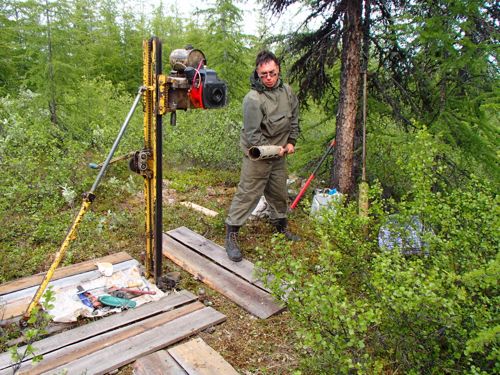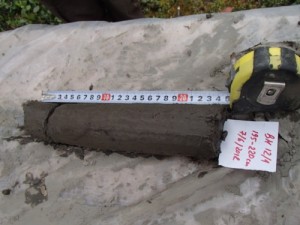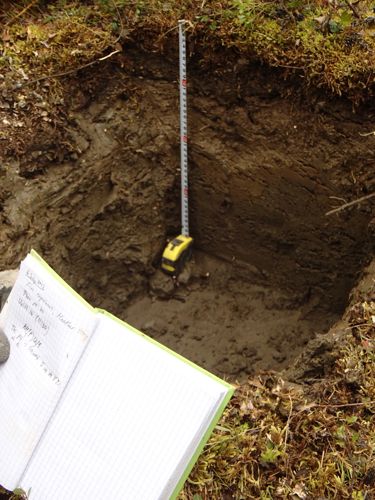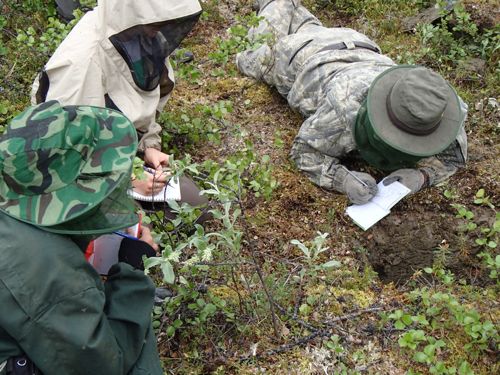(This post is by Mark Paricio, a PolarTREC teacher accompanying the Polaris Project this year.
To read all of Mark’s posts, go to: http://www.polartrec.com/expeditions/siberian-arctic-systems-study )
How can you get your hands on permafrost?
Over the last few days, I have had the opportunity to accompany Dr. Valentin Spektor of the Melnikov Permafrost Institute in Yakutsk, Russia, and Dr. Alexander (Sasha) Kholodov of the University of Alaska at Fairbanks as they use their drilling equipment to bore into the ground and collect permafrost core samples. Also working with us are Varvara Andreeva (a student of Dr. Spektor’s from the Northeast Federal University in Yakutsk) and Dylan Broderick from Clark University.
As an engineer, I am impressed with the simplicity and the sturdiness of the portable drilling rig and the skill with which Sasha, our drilling expert, handles the equipment. As the small gas powered motors that power the drilling have not been used since last year, Sasha and Valentin have spent a couple of days tuning the finicky motors. When we started on Friday, Sasha essentially rebuilt one engine on the drilling rig with mixed results, drilling about 2 meters into the permafrost. Yesterday, he replaced the motor with an older different Soviet era motor and it worked very well – drilling 4 meters down to a depth of about 6 meters. This goes to show the value of having mechanical skills as a scientist – as well as the value of persistence!

Dr. Alexander (Sasha) Kholodov carries a bore hole bit toward the drilling rig. The hollow bit allows the core to slide up and into the bit for extraction.
This morning, we drilled 4 more meters. It is a ton of work – literally – lifting 10 solid steel meter-long rods up and down into position twice for every 40 cm we drill. First we drill for the core with a thinner bore tool, then we drill it again with a larger diameter bit to widen the hole so that we have a little bit easier time getting the long rods in and out. I am glad I had a summer job with an oil company in college that introduced me to drilling. Although it is a slightly different process when trying to extract a core, this experience allows me to be a little more helpful to Sasha.
What Happens to a Permafrost Core?
When a core is successfully brought to the surface of the bore hole, a wonderful scientific process begins that is a true pleasure to watch. Under the supervision and mentoring of Valentin, a remarkably curious and jovial man, the cores are removed, measured, divided, tagged and stored. Cores are placed on a field lab table constructed using logs between two standing trees that has a groove in it to place the cores so they can not roll off. Valentin is an exceptional mentor to the undergraduate students, Varvara and Dylan, while handling the samples in the field.

Here is a 25 cm-long permafrost core. This one contains almost no ice. Later cores had considerably different compositions.
Each core is divided into several pieces to be tested for a variety of measurements. Slices are made to test bulk density, carbon and moisture content, pollen from ancient plants, and microbiological analysis. One additional section is kept frozen for other purposes that may arise.
When the drill rig is not working or the motor is cooling, the team digs a pit 5 meters from the drill site through the thawed soil active layer down to where the permafrost layer begins. Interestingly, when the permafrost layer is reached, it is like hitting a solid rock layer that provides a flat floor to the pit.

This is our first 45 cm-deep pit through the active layer of soil. Notice the flat floor of the pit where the permafrost begins. Also notice the depth of the moss layer.
Many parameters are measured in the active layer pit including the thickness of the moss layer (the soil organic layer), the depth of the active layer down to the permafrost, temperature, moisture content, and the thermal conductivity of the soil (the ability of the soil to conduct heat down to the permafrost layer). Then, Sasha placed several sensors at various depths including into the permafrost and the pit is filled back in carefully, including replacing the moss layer. It is difficult to see where the pit was if you do not know what you were looking for.

Varvara, Dylan, and Dr. Valentin Spektor (L to R) make observations of the pit. Valentin tutored the students on what observations were important. Numerous instruments were later added to make quantitative measurements.
As I write this, I am sitting in the dining room, waiting for our 2:00 p.m. lunch to begin. The smell from the kitchen is amazing! (I will write about the living conditions in a later journal entry.) So it’s a quick lunch and, as eventual goal for this bore hole is to reach 15 meters down, it’s back to work!
Stay curious my friends! – Mark Paricio




Comment(1)-
Joanne Heslop says
July 13, 2012 at 7:25 pmValentin, these cores look beautiful. It’s so great there’s an actual coring machine this year. Are they the ones you were planning to do the BODs on?